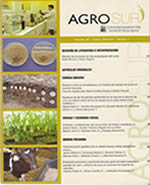Grazing behavior of two breeds of ewes on a secondary ecological succession of the Chiloé Island
Main Article Content
Abstract
The aim of this experiment was to determine the grazing behavior of the Chilota and Suffolk Down breeds of sheep on a secondary ecological succession (such as a calafatal) in Chiloé. The experiment was performed between October and December 2011. Eight Chilota and 6 Suffolk Down ewes (intraracial similar weight and body condition) and their lambs, were selected and marked with an identification number on their backs. Three 1 ha paddocks located within a calafatal were used. Data recording was performed during 24 h, once a month, for 3 consecutive months by direct observation and manual recording of the following activities: grazing, standing, lying ruminating, standing ruminating, lying, walking and browsing. In this experiment, the Chilota ewes showed longer grazing times than the Suffolk Down ewes, despite their lower requirements and body size, spending less time walking at night than the Suffolk Down ewes. Also, the probability of occurrence of grazing behavior in this breed was higher than in Suffolk Down ewes. Monthly data indicated that the Chilota ewes showed shorter standing times (in October) and longer grazing times (in December) than the Suffolk Down ewes, according to a higher pasture availability. In summary, the Chilota ewes showed longer grazing times than the Suffolk Down ewes, spending less time standing ruminating during daylight or walking at night than the Suffolk Down ewes.

